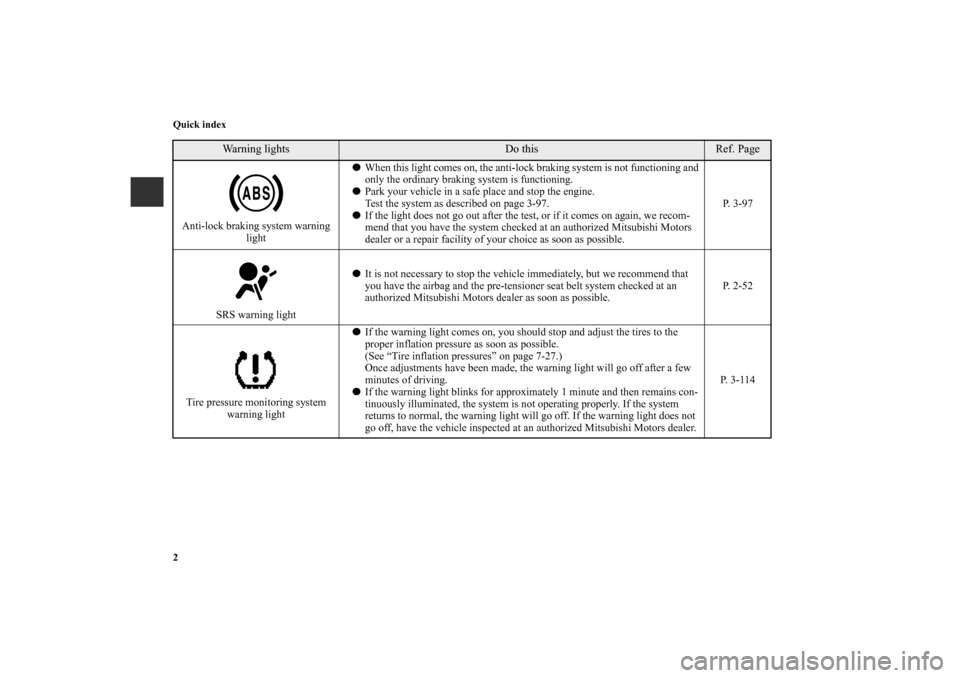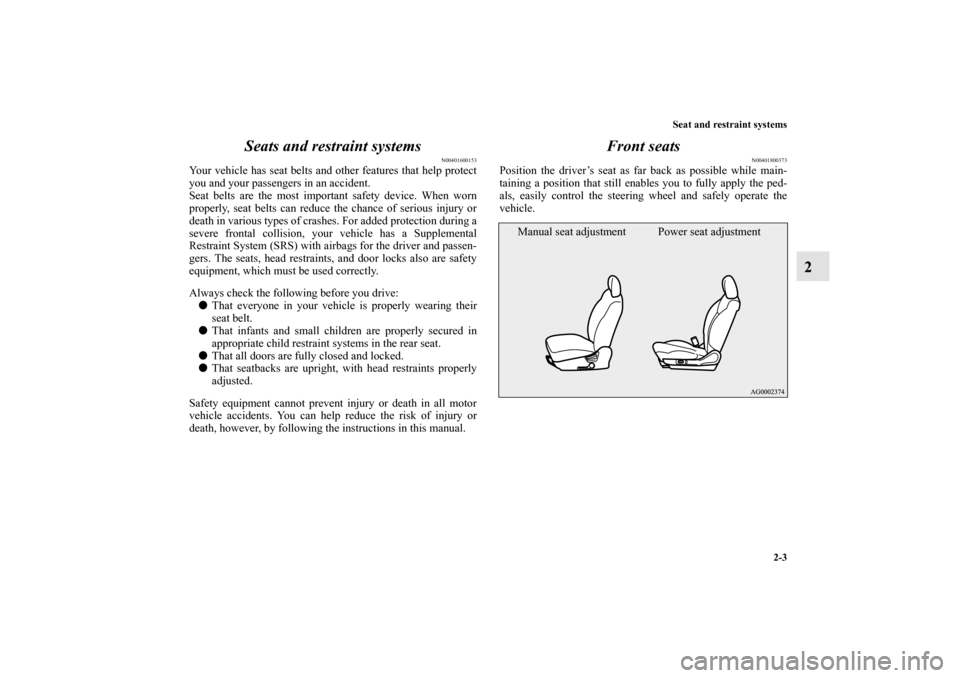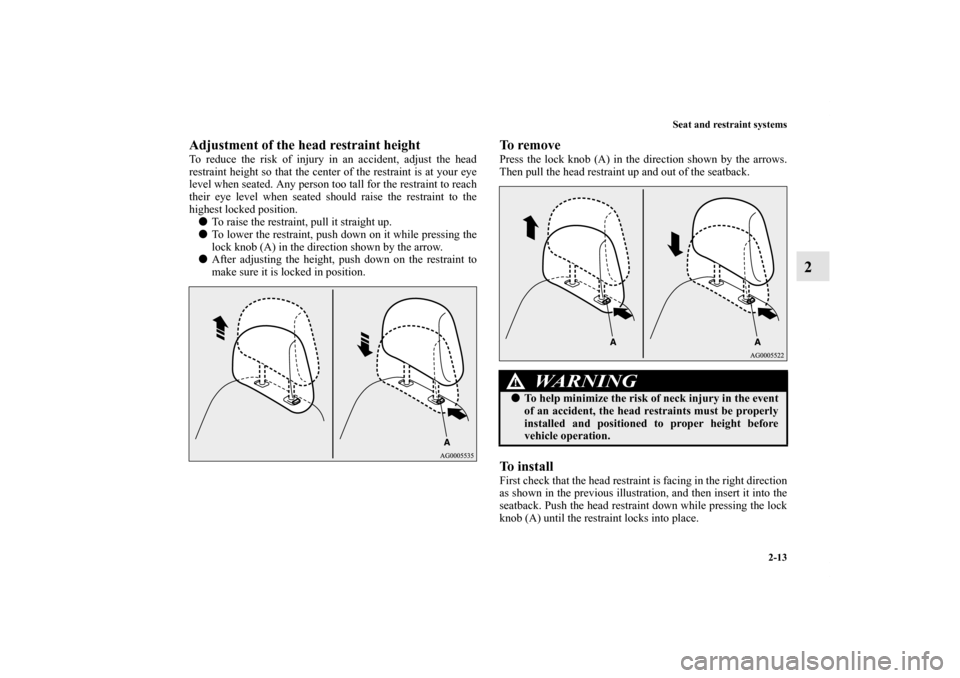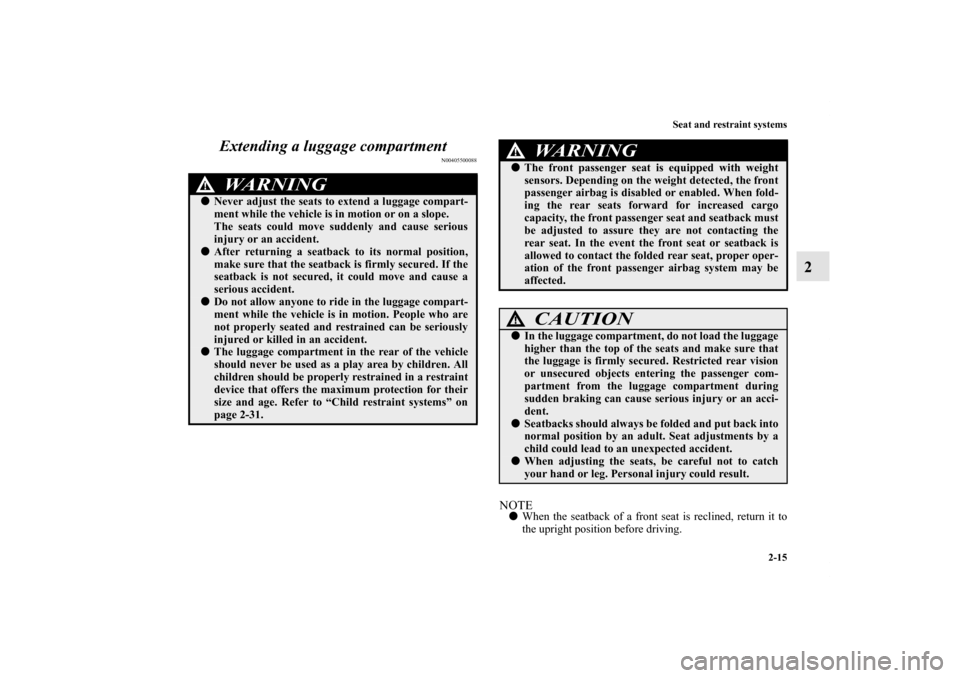Page 11 of 602

2 Quick indexAnti-lock braking system warning
light�When this light comes on, the anti-lock braking system is not functioning and
only the ordinary braking system is functioning.
�Park your vehicle in a safe place and stop the engine.
Test the system as described on page 3-97.
�If the light does not go out after the test, or if it comes on again, we recom-
mend that you have the system checked at an authorized Mitsubishi Motors
dealer or a repair facility of your choice as soon as possible.P. 3-97
SRS warning light�It is not necessary to stop the vehicle immediately, but we recommend that
you have the airbag and the pre-tensioner seat belt system checked at an
authorized Mitsubishi Motors dealer as soon as possible.P. 2-52
Tire pressure monitoring system
warning light�If the warning light comes on, you should stop and adjust the tires to the
proper inflation pressure as soon as possible.
(See “Tire inflation pressures” on page 7-27.)
Once adjustments have been made, the warning light will go off after a few
minutes of driving.
�If the warning light blinks for approximately 1 minute and then remains con-
tinuously illuminated, the system is not operating properly. If the system
returns to normal, the warning light will go off. If the warning light does not
go off, have the vehicle inspected at an authorized Mitsubishi Motors dealer.P. 3 - 1 1 4
Warning lights
Do this
Ref. Page
BK0120400US.book 2 ページ 2010年5月12日 水曜日 午前10時50分
Page 30 of 602

Seat and restraint systems
2-3
2 Seats and restraint systems
N00401600153
Your vehicle has seat belts and other features that help protect
you and your passengers in an accident.
Seat belts are the most important safety device. When worn
properly, seat belts can reduce the chance of serious injury or
death in various types of crashes. For added protection during a
severe frontal collision, your vehicle has a Supplemental
Restraint System (SRS) with airbags for the driver and passen-
gers. The seats, head restraints, and door locks also are safety
equipment, which must be used correctly.
Always check the following before you drive:
�That everyone in your vehicle is properly wearing their
seat belt.
�That infants and small children are properly secured in
appropriate child restraint systems in the rear seat.
�That all doors are fully closed and locked.
�That seatbacks are upright, with head restraints properly
adjusted.
Safety equipment cannot prevent injury or death in all motor
vehicle accidents. You can help reduce the risk of injury or
death, however, by following the instructions in this manual.
Front seats
N00401800373
Position the driver’s seat as far back as possible while main-
taining a position that still enables you to fully apply the ped-
als, easily control the steering wheel and safely operate the
vehicle.
Power seat adjustment Manual seat adjustment
BK0120400US.book 3 ページ 2010年5月12日 水曜日 午前10時50分
Page 32 of 602
Seat and restraint systems
2-5
2
To adjust the seat forward or backward
N00401900228
Manual seat adjustmentPull the seat adjusting lever up and slide the seat forward or
backward to the desired position. Release the adjusting lever to
lock the seat in place.
Power seat adjustmentOperate the switch forward or backward to move the seat to the
desired position. Release the switch to lock the seat in place.NOTE�To prevent the battery from going dead, operate the power
seat with the engine running.
WA R N I N G
!�To make sure that the seat is securely locked, try to
move it forward or backward without using the
adjusting lever.
1- Forward (toward the front of the vehicle)
2- Backward (toward the rear of the vehicle)
BK0120400US.book 5 ページ 2010年5月12日 水曜日 午前10時50分
Page 33 of 602
2-6 Seat and restraint systems
2
To adjust the seatbacks
N00402000268
Manual seat adjustmentTo adjust the seatback, lean forward slightly, gently pull the
seatback lock lever up, then lean backward to a comfortable
position and release the lever. The seatback will lock in place.
Power seat adjustmentOperate the switch in the direction of the arrows to adjust the
seatback.NOTE�To prevent the battery from going dead, operate the power
seat with the engine running.
CAUTION
!�The reclining mechanism used in the seatback is
spring loaded, and will cause the seatback to return
quickly to the vertical position when the lock lever is
operated. When pulling the lever, sit close to the
seatback or hold the seatback with your hand to
control its return motion.
1- Move forward
2- Move backward
BK0120400US.book 6 ページ 2010年5月12日 水曜日 午前10時50分
Page 34 of 602
Seat and restraint systems
2-7
2
To adjust the seat height (Driver’s seat only)
N00402100197
Manual seat adjustmentOperate the lever repeatedly to raise or lower the seat.
WA R N I N G
!�To reduce the risk of serious injury or death in the
event of an accident or sudden stop, all seatbacks
should be kept in the upright position while the vehi-
cle is in motion.
Seat belt performance during an accident can be
adversely affected if the seatbacks are reclined. The
more a seatback is reclined, the more likely seat belt
performance will be adversely affected. If the seat
belt is not properly positioned against the body dur-
ing an accident, there is increased risk you will slide
under the belt and receive serious injury or death.
1- Raise
2- Lower
BK0120400US.book 7 ページ 2010年5月12日 水曜日 午前10時50分
Page 35 of 602
2-8 Seat and restraint systems
2
Power seat adjustmentOperate the switch in the direction of the arrows to raise or
lower the seat.NOTE�To prevent the battery from going dead, operate the power
seat with the engine running.1- Raise or lower the front end of the seat
2- Raise or lower the back end of the seat
3- Raise or lower the entire seat
BK0120400US.book 8 ページ 2010年5月12日 水曜日 午前10時50分
Page 40 of 602

Seat and restraint systems
2-13
2
Adjustment of the head restraint heightTo reduce the risk of injury in an accident, adjust the head
restraint height so that the center of the restraint is at your eye
level when seated. Any person too tall for the restraint to reach
their eye level when seated should raise the restraint to the
highest locked position.
�To raise the restraint, pull it straight up.
�To lower the restraint, push down on it while pressing the
lock knob (A) in the direction shown by the arrow.
�After adjusting the height, push down on the restraint to
make sure it is locked in position.
To r e m o v ePress the lock knob (A) in the direction shown by the arrows.
Then pull the head restraint up and out of the seatback.To installFirst check that the head restraint is facing in the right direction
as shown in the previous illustration, and then insert it into the
seatback. Push the head restraint down while pressing the lock
knob (A) until the restraint locks into place.
WA R N I N G
!�To help minimize the risk of neck injury in the event
of an accident, the head restraints must be properly
installed and positioned to proper height before
vehicle operation.
BK0120400US.book 13 ページ 2010年5月12日 水曜日 午前10時50分
Page 42 of 602

Seat and restraint systems
2-15
2 Extending a luggage compartment
N00405500088
NOTE�When the seatback of a front seat is reclined, return it to
the upright position before driving.
WA R N I N G
!�Never adjust the seats to extend a luggage compart-
ment while the vehicle is in motion or on a slope.
The seats could move suddenly and cause serious
injury or an accident.�After returning a seatback to its normal position,
make sure that the seatback is firmly secured. If the
seatback is not secured, it could move and cause a
serious accident.�Do not allow anyone to ride in the luggage compart-
ment while the vehicle is in motion. People who are
not properly seated and restrained can be seriously
injured or killed in an accident.�The luggage compartment in the rear of the vehicle
should never be used as a play area by children. All
children should be properly restrained in a restraint
device that offers the maximum protection for their
size and age. Refer to “Child restraint systems” on
page 2-31.
�The front passenger seat is equipped with weight
sensors. Depending on the weight detected, the front
passenger airbag is disabled or enabled. When fold-
ing the rear seats forward for increased cargo
capacity, the front passenger seat and seatback must
be adjusted to assure they are not contacting the
rear seat. In the event the front seat or seatback is
allowed to contact the folded rear seat, proper oper-
ation of the front passenger airbag system may be
affected.
CAUTION
!�In the luggage compartment, do not load the luggage
higher than the top of the seats and make sure that
the luggage is firmly secured. Restricted rear vision
or unsecured objects entering the passenger com-
partment from the luggage compartment during
sudden braking can cause serious injury or an acci-
dent.�Seatbacks should always be folded and put back into
normal position by an adult. Seat adjustments by a
child could lead to an unexpected accident.�When adjusting the seats, be careful not to catch
your hand or leg. Personal injury could result.
WA R N I N G
!
BK0120400US.book 15 ページ 2010年5月12日 水曜日 午前10時50分